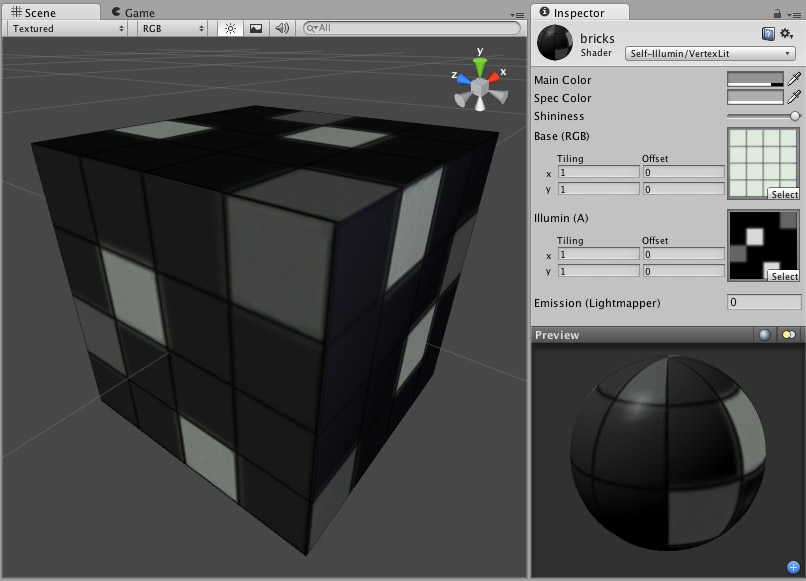Self-Illuminated Vertex-Lit
Note. Unity 5 introduced the Standard ShaderA built-in shader for rendering real-world objects such as stone, wood, glass, plastic and metal. Supports a wide range of shader types and combinations. More info
See in Glossary which replaces this shaderA small script that contains the mathematical calculations and algorithms for calculating the Color of each pixel rendered, based on the lighting input and the Material configuration. More info
See in Glossary.

Self-Illuminated Properties
Note. Unity 5 introduced the Standard Shader which replaces this shader.
This shader allows you to define bright and dark parts of the object. The alpha channel of a secondary texture will define areas of the object that “emit” light by themselves, even when no light is shining on it. In the alpha channel, black is zero light, and white is full light emitted by the object. Any sceneA Scene contains the environments and menus of your game. Think of each unique Scene file as a unique level. In each Scene, you place your environments, obstacles, and decorations, essentially designing and building your game in pieces. More info
See in Glossary lights will add illumination on top of the shader’s illumination. So even if your object does not emit any light by itself, it will still be lit by lights in your scene.
Vertex-Lit Properties
Note. Unity 5 introduced the Standard Shader which replaces this shader.
This shader is Vertex-Lit, which is one of the simplest shaders. All lights shining on it are rendered in a single pass and calculated at vertices only.
Because it is vertex-lit, it won’t display any pixel-based renderingThe process of drawing graphics to the screen (or to a render texture). By default, the main camera in Unity renders its view to the screen. More info
See in Glossary effects, such as light cookies, normal mapping, or shadows. This shader is also much more sensitive to tesselation of the models. If you put a point light very close to a cube using this shader, the light will only be calculated at the corners. Pixel-lit shaders are much more effective at creating a nice round highlight, independent of tesselation. If that’s an effect you want, you may consider using a pixel-lit shader or increase tesselation of the objects instead.
Performance
Generally, this shader is cheap to render. For more details, please view the Shader Peformance page.
Did you find this page useful? Please give it a rating: